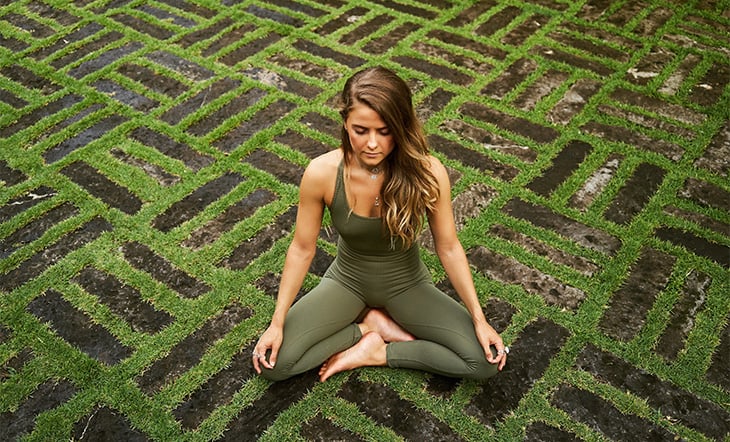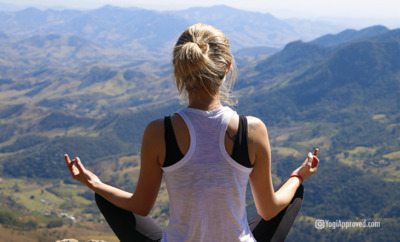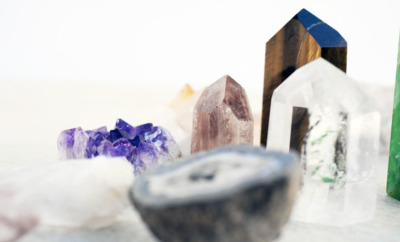How to Embrace Your Vata Dosha and Feel Grounded AF

Vatta
Let’s talk about Ayurveda doshas. There are three main doshas, or constitutions, that we are made up of – according to Ayurveda. You may have heard of these already: vata dosha, pitta dosha, and kapha dosha.
In this article, we will discuss what it means to have a Vata dosha so you can start feeling more focused, grounded, and healthy.
First, let’s start with a brief background on Ayurveda and the Ayurvedic doshas.
The History and Science Behind Ayurveda
Ayurveda is a 5,000-year-old, alternative holistic Indian practice that combines an intentional diet and lifestyle to achieve a harmonious balance within the mind, body, and spirit.
In Sanskrit Ayurveda means “the science of life.” Think of it as a guideline for us to make healthy lifestyle choices that are in tune with nature.
What makes Ayurveda so appealing to yogis is that it’s intuitive and ever-changing based on your season of life. Anyone can enjoy making healthy lifestyle shifts guided by these Ayurvedic beliefs. So, what does this mean for you?
Ayurveda means “the science of life.” Think of it as a guideline for us to make healthy lifestyle choices that are in tune with nature.
To start, it’s important to understand your Ayurvedic constitution.
The Ayurvedic constitution represents the five elements including earth, air, water, fire, and space that form the traits for your ayurvedic profile. While everyone has different concentrations of these traits, they fall into three major forces, or doshas, known as vata, pitta and kapha.
Ayurveda Doshas: How Do You Determine Your Personal Dosha?
Why do you want to understand your dosha? Understanding your Ayurvedic constitution will help you choose the right foods, workouts, and types of self-care best suited for your needs.
What Is Your Dosha? Here’s Everything You Need to Know About These Ayurvedic Mind-Body Types
What Does It Mean to Be a Vata Dosha?
The main qualities of vata are dry, light, sensitive, flighty, creative, and distracted. These characteristics can show up in both your emotional and physical body. Each of us holds a combination of three traits.
A pitta dosha carries “fire” or heat energy, kapha represents water and earth, a sense of “heaviness,” and vata represents air or wind energy. Vata is one of the most important of the three because a vata imbalance can lead to an imbalance in other doshas as well.
Anything involving movement requires healthy vata energy. In addition to exercise, this includes chewing, nerve impulses, breathing, muscle movements, thinking, elimination, peristalsis, or menstruation. As a whole, vata energy is important for sending the proper messages to the brain (that’s a pretty big deal).
Vata is one of the most important of the three because a vata imbalance can lead to an imbalance in other doshas as well.
A vata body type is naturally thin, quick-moving, has smaller eyes, and skin that tends to be dry. It’s often hard for vatas to “sit still” when there’s so much to do!
A healthy vata has high energy and strong creative gifts for things like writing, art, and music. Vatas also tend to be intuitive, empathic, and highly sensitive. Sound like anyone you know?
Emotionally, someone with a predominantly vata dosha also tends to worry, be anxiety-prone, restlessness, quick-thinking, and forgetful. Their sleep is light and full of creative, flying, or running dreams.
When someone with this constitution becomes imbalanced, it can cause things like aches, lack of sleep, anxiety, constipation, and concentration problems. Our mental health, like our physical health, is vital. Therefore, it’s essential to maintain this balance.
Vata Imbalance: What Does It Mean?
When we experience stress or ingest toxins, it creates a surge of vata energy that can quickly throw us off balance. Imbalances in our bodies can lead to chronic conditions, or even simply “not feeling well.”
However, there are natural, simple ways to counteract excess vata energy in the body when you start to notice symptoms of anxiety, dryness, and irregularity in your digestion or menstrual cycles.
Creating balance in Ayurveda involves certain behaviors, eating foods, or creating routines that have opposing energies to each specific dosha.
If you’re experiencing excess vata, you’ll want to do more things in your life or eat more foods that will “pacify” or lower that vata energy. In this case, like attracts like, so you don’t want to eat foods that increase vata any further.
Again, think dry, wind, and air . . . (Do you know someone you can describe as “spacey” or “airy?” That’s what we’re talking about here).
When you start to feel like you are “all over the place” or are feeling ungrounded, there are several things you can do to calm your systems and feel like yourself again.
How to Balance Your Vata Dosha With Food
You can “pacify” your extra vata energy with calming, soothing and warming foods and activities. Since vata tends to be dry (causing dry skin and constipation), think about eating foods that are wet, oily, and heavy.
Incorporate it into your diet by adding organic sesame or olive oil to your meals and cook with clarified butter or ghee and be sure to drink room-temperature to warm liquids all year round, especially in winter months.
Heavier foods like soups and stews filled with healthy vegetables and high-quality oils will counteract the flighty energy of vata. Aim for creamy soups, clean animal proteins like fish and eggs, grounding root vegetables like sweet potatoes and parsnips and hearty whole grains.
Avoid light and dry foods like pretzels, raisins, popcorn, and cold, raw salads. That’s not to say that cooling, cleansing salads and vegetables aren’t full of nutrients, but their cold, raw energy can exacerbate vata energy and actually slow digestion further.
Curious about a diet that supports Ayurvedic doshas? Here’s How to Eat for Your Dosha + Which Foods You Should Avoid
How to Balance Your Vata Dosha With Movement and Self-Care
Resist overexerting yourself as a vata. Pilates and yoga poses that are steady, grounding, and restorative are ideal. Also, try walking barefoot on the earth (on sand, dirt, whatever – this is known as earthing) and take in some quality time in nature.
Earthing: How This Practice Connects Your Mind and Body
Naps, resting and reading outside, going for walks, and getting a massage are very healthy and realistic activities that can help you relax. Remember to focus on energies that oppose the dry, airy, and tense energy of excess vata.
Vatas thrive on a consistent routine! Eating mindfully, keeping a regular daily schedule like going to bed and waking up around the same time each day, and prioritizing meditation all support a vata routine.
It’s helpful to dress warmly and always have a sweater or scarf with you so that you’re comfortable. You can also apply sesame or almond oil right onto your skin for a hydrating, soothing, self-massage. This will lead to a grounded, balanced vata who can then focus her creative energies on something other than overthinking and panicking.
What Is the Best Meditation For Your Dosha? Take the Quiz to Find Out!
Embrace Your Free-Flowing Energy as a Vata Dosha
Vata doshas can get a bad reputation for being flighty, distracted, and “all over the place,” but this isn’t the case 100 percent of the time. No one wants to feel unfocused and unreliable.
Embrace your energetic spirit while being self-aware and prepared to counteract any vata imbalances that come up.
Always listen to your body, and acknowledge how you feel. As you become more self-aware, you can apply these natural suggestions to ease any discomfort that comes from excess vata in your body and bring yourself back to Earth as a free-flowing, confident creative.
All included information is not intended to treat or diagnose. The views expressed are those of the author and should be attributed solely to the author. For medical questions, please consult your healthcare provider.


This Month's Letter
From the Editor
Monthly motivation and food for
thought from our founder.





























